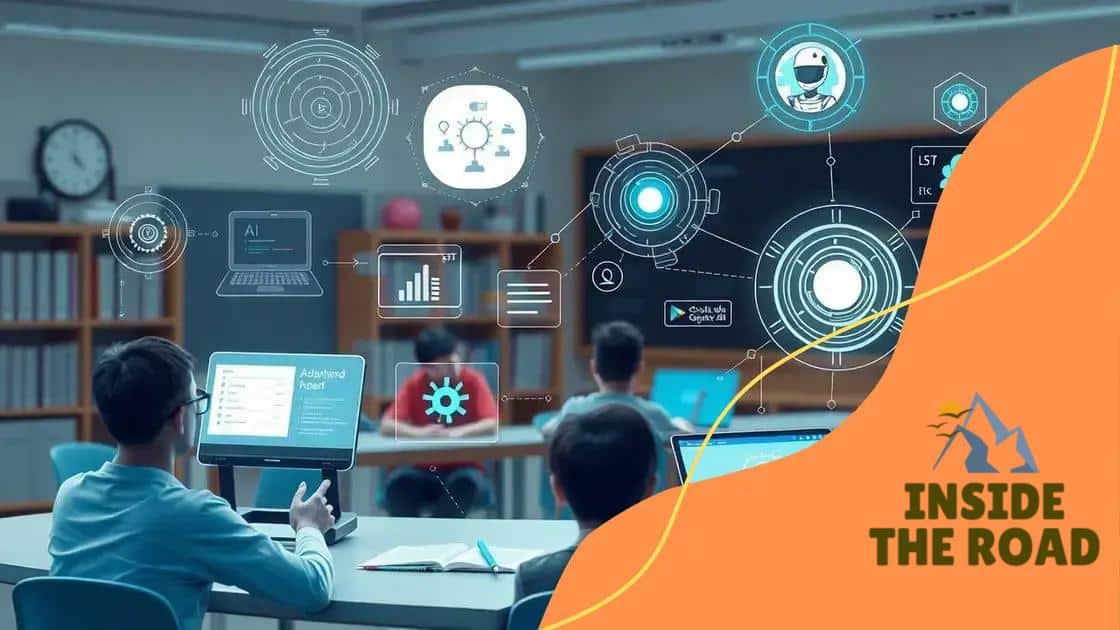How AI is being used for teacher training and development

AI is being used for teacher training and development by providing personalized learning experiences, data-driven insights, and innovative collaboration tools that enhance educators’ skills and effectiveness in the classroom.
How AI is being used for teacher training and development is a game changer for educators. Imagine a world where teachers have personalized resources at their fingertips, tailored just for their needs. Curious about how this is shaping the future of education?
The role of AI in modern teacher training
The role of AI in modern teacher training is becoming increasingly important. Educators today have access to tools that can enhance their teaching methods and help them grow professionally. These advancements are changing the landscape of how teachers are trained and supported.
Why AI is Essential for Teacher Training
With AI, teacher training can be personalized. This means that each teacher can receive training that fits their specific needs and skills. AI analyzes data from various sources to create tailored training programs.
Some benefits of using AI in teacher training include:
- Improved efficiency in training processes
- Targeted learning experiences
- Access to a vast amount of resources
- Enhanced feedback systems
Additionally, AI allows for real-time tracking of teachers’ progress. This capability helps trainers understand what aspects of the training are effective and what needs adjustment. For example, an AI system can highlight areas where a teacher may struggle, allowing for more focused support.
Examples of AI Tools in Teacher Training
There are several AI tools currently being used in teacher training programs. Some popular ones include:
- Adaptive Learning Platforms: These adjust content based on individual teacher performance.
- Virtual Mentoring: AI can simulate mentoring experiences allowing trainees to receive guidance online.
- Data Analytics: Helps trainers evaluate the effectiveness of their programs over time.
Each of these tools demonstrates how AI can improve the training experience for teachers. By integrating such technologies, schools can ensure that their educators are well-prepared for the challenges ahead.
As we look to the future, it’s clear that the integration of AI in teacher training will continue to evolve. With ongoing advancements, the possibilities for enhancing educational practices are limitless. AI technologies are set to redefine how teachers are prepared, supported, and appreciated in their roles.
Benefits of AI for teacher professional development
The benefits of AI for teacher professional development are significant and multifaceted. Educators can now enhance their skills in a more flexible and effective manner. With AI, training is not only accessible but also personalized to fit individual growth.
Personalized Learning Experiences
One of the standout advantages of AI in professional development is its ability to create personalized learning experiences. AI can assess a teacher’s strengths and weaknesses, enabling a tailored approach to their development.
Some key benefits include:
- Customized learning paths based on individual needs
- Focused resources that target specific skill gaps
- Flexible scheduling that accommodates busy teachers
This personalization leads to teachers feeling more engaged and motivated in their professional growth. When teachers receive support directly aligned with their needs, they are more likely to succeed.
Access to Rich Resources
AI also opens the door to a wealth of resources. Teachers can access a wide range of materials, including:
- Interactive lessons and modules
- Video tutorials from experts
- Peer networking opportunities
This access allows teachers to learn from others and explore new methodologies. As they discover fresh ideas and strategies through AI, they can enhance their teaching practices effectively.
Moreover, AI-driven platforms often provide real-time feedback on teaching methods. This feedback is essential, as it allows educators to adjust their approaches immediately, leading to better classroom results.
Ultimately, the integration of AI into teacher professional development transforms how educators grow. It fosters a culture of continuous improvement, ensuring that teachers are well-equipped to meet the challenges of modern education. As these technologies evolve, so too will the opportunities for educators to thrive in their careers.
Technologies driving AI in education

Technologies driving AI in education are transforming how teachers and students interact in the learning environment. These innovations are paving the way for a more efficient and customized educational experience.
Adaptive Learning Systems
One key technology leading the charge is adaptive learning systems. These systems use AI algorithms to assess each student’s learning style and progress. By analyzing data, they can adjust the difficulty of tasks and provide personalized resources based on individual needs.
Benefits of adaptive learning include:
- Real-time feedback on student performance
- Tailored educational content that fits learner profiles
- Increased engagement through customized experiences
This technology not only supports students but also assists teachers in identifying areas where students may struggle.
Learning Analytics
An additional innovation is learning analytics. This tool gathers data on student performance and engagement. By understanding how students interact with educational materials, AI can guide educators in refining their teaching strategies.
Some key features of learning analytics include:
- Data visualization tools for better understanding
- Identifying patterns in student behavior
- Providing insights to improve curriculum effectiveness
As educators have access to more data, they can make informed decisions that enhance the learning process.
Furthermore, AI chatbots and virtual assistants are gaining traction. They provide instant support to students and teachers alike. These tools help answer questions, offer explanations, and even facilitate administrative tasks, freeing up valuable time for educators to focus on teaching.
Overall, technologies driving AI in education are not only improving teaching methods but also creating richer learning experiences for students. As these technologies continue to evolve, the potential for growth in the educational sector remains vast, ensuring that both teachers and learners can thrive in a dynamic environment.
Success stories of AI in teacher training
Success stories of AI in teacher training showcase the positive impact that technology can have on educational practices. Many schools and institutions have embraced AI to enhance their training programs, leading to remarkable improvements in educator effectiveness.
Case Study: Personalized Learning at ABC Academy
At ABC Academy, the integration of AI has transformed how teachers receive training. By implementing an adaptive learning platform, the academy offers personalized modules. Each teacher follows a unique pathway tailored to their strengths and areas for improvement, which has led to greater engagement and higher retention rates.
Some outcomes of this initiative include:
- Increased teacher satisfaction with training programs
- Higher student engagement due to improved teaching methods
- Measurable gains in classroom performance
Such success illustrates how understanding individual needs makes professional development more effective.
Transformative Impact at XYZ University
XYZ University also reports a significant positive shift in its teacher training program through AI. By utilizing a virtual mentoring system, new teachers receive on-the-spot coaching from experienced educators who are analyzed through AI for key teaching behaviors.
This approach has resulted in:
- Enhanced real-time feedback for novice teachers
- Stronger mentorship relationships
- Reduced dropout rates among new educators
New educators are now better prepared for the challenges of classroom management and curriculum delivery.
Moreover, several districts have adopted AI-powered assessments to predict teacher performance. By analyzing evaluation data, these systems identify key training needs, allowing for targeted interventions that improve teaching outcomes significantly.
These success stories exemplify how AI is not only modernizing teacher training but effectively equipping educators with the necessary tools for ongoing success. As these technologies continue to develop, the stories of positive impact will surely grow, inspiring more institutions to follow suit.
Future trends in AI for educator development
Future trends in AI for educator development point towards a more personalized and data-driven approach to teaching. As technology evolves, the opportunities for integrating AI into professional development will expand significantly, benefiting both teachers and students.
Increased Personalization
One major trend is the move towards hyper-personalized learning experiences for educators. Future AI tools are expected to analyze vast amounts of data to tailor professional development programs to the unique needs of each teacher.
This could include:
- Customized training modules based on teaching style
- Immediate feedback tailored to individual performance
- Resource recommendations aligned with specific goals
Such customization ensures that each educator receives the most relevant training, leading to improved teaching outcomes.
AI-Driven Collaboration Platforms
Another promising trend is the rise of collaborative platforms powered by AI. These platforms will facilitate connections between teachers, allowing them to share ideas, resources, and best practices seamlessly.
Potential features of these platforms might include:
- Real-time discussions and brainstorming sessions
- Access to a repository of shared materials
- Analytics that track engagement and effectiveness
Through collaborative efforts, teachers can learn from one another and build strong professional communities.
Additionally, future AI tools may incorporate virtual reality (VR) and augmented reality (AR) technologies for immersive training experiences. Imagine teachers stepping into a VR classroom to practice their skills or learn new strategies in simulated environments. This hands-on approach could revolutionize educator development.
As data analytics continue to improve, institutions may leverage predictive models to identify potential challenges in teaching practices before they arise. By using AI to analyze trends, schools can proactively offer support and resources where they are most needed.
Overall, the future of AI in educator development looks bright. With advancements in personalization, collaboration, and immersive training, teachers will be better equipped to thrive in ever-changing educational landscapes.
AI in teacher training and development is essential for creating a more effective and engaging educational experience. AI offers personalized learning, innovative collaboration tools, and valuable insights that help educators thrive. The future of education looks promising with these advancements, empowering teachers to adapt and grow in today’s fast-paced world. As technology continues to evolve, so will the opportunities for educators to enhance their skills and improve student outcomes, making AI an indispensable part of teacher professional development.
FAQ – Frequently Asked Questions about AI in Teacher Training
How can AI improve personalized learning for teachers?
AI analyzes individual teacher performance and learning styles, allowing for tailored training programs that address specific needs.
What are some AI-driven collaboration tools for educators?
AI collaboration tools help teachers connect, share resources, and exchange ideas in real-time, fostering a supportive community.
How does data analytics benefit teacher professional development?
Data analytics provides insights into teaching practices, enabling schools to identify areas for improvement and offer targeted support.
What future trends should we expect in AI for educator development?
Future trends include more personalized learning experiences, immersive training through VR, and enhanced collaboration platforms.






